Toward Modern Pesticide Use Reduction Strategies in Advancing Precision Agriculture: A Bibliometric Review
Abstract
1. Introduction
1.1. Importance of Sustainable Plant Protection
1.2. Core Technologies in Advancing PA
1.3. Applications of PA-Based Technologies
1.4. Research Questions and Review Structure
2. Materials and Methods
2.1. Bibliometric Analysis
2.2. Data Collection
2.3. Search Methodology
- Precision agriculture (PA)-related terms: This set included keywords pertaining to the domain of precision farming, also incorporating synonymous and equivalent terms to ensure a broad and relevant dataset.
- Plant protection product (PPP)-related terms: This set included keywords referring to agrochemical products and related terminology, thereby ensuring that the selected works addressed this specific area.
2.4. Dataset Analysis
3. Results
3.1. Annual Scientific Production
3.2. Scientific Publications and Co-Authorship Analysis
3.3. Most Prolific Authors
3.4. Co-Occurrence Analysis
3.5. Number of Articles in Journals
3.6. Co-Citation Analysis
3.7. Quantitative Distribution of Topics
3.8. Time Distribution of Topics
4. Summary and Future Directions
- Identify conceptual synergies between different sub-categories through a broad mapping of the literature;
- Define “bridge topics” that connect decision support systems and in-field implementation, helping the integration of technologies into complex operations;
- Analyze overlaps between research areas, showing future directions for more integrated solutions.
Author Contributions
Funding
Data Availability Statement
Conflicts of Interest
References
- Yaqot, M.; Menezes, B.C.; Al-Ansari, T. Roadmap to precision agriculture under circular economy constraints. J. Inf. Knowl. Manag. 2023, 22, 2250092. [Google Scholar] [CrossRef]
- Rusmayadi, G.; Mulyanti, D.R.; Alaydrus, A.Z.A. Revolutionizing agrotechnology: Meeting global food demand through sustainable and precision farming innovations. West Sci. Interdiscip. Stud. 2023, 1, 600–609. [Google Scholar] [CrossRef]
- Basso, B.; Antle, J. Digital agriculture to design sustainable agricultural systems. Nat. Sustain. 2020, 3, 254–256. [Google Scholar] [CrossRef]
- McConnell, L.L.; Kelly, I.D.; Jones, R.L. Integrating Technologies to Minimize Environmental Impacts. In Agricultural Chemicals and the Environment: Issues and Potential Solutions; The Royal Society of Chemistry: London, UK, 2016. [Google Scholar] [CrossRef]
- Tudi, M.; Ruan, H.D.; Wang, L.; Lyu, J.; Sadler, R.; Connell, D.; Chu, C.; Phung, D.T. Agriculture Development, pesticide application and its impact on the environment. Int. J. Environ. Res. Public Health 2021, 18, 1112. [Google Scholar] [CrossRef]
- Nicolopoulou-Stamati, P.; Maipas, S.; Kotampasi, C.; Stamatis, P.; Hens, L. Chemical pesticides and human health: The urgent need for a new concept in agriculture. Front. Public Health 2016, 4, 148. [Google Scholar] [CrossRef] [PubMed]
- Calegari, F.; Tassi, D.; Vincini, M. Economic and environmental benefits of using a spray control system for the distribution of pesticides. J. Agric. Eng. 2013, 44, s2. [Google Scholar] [CrossRef]
- Dara, S.K. The new integrated pest management paradigm for the modern age. J. Integr. Pest Manag. 2019, 10, 12. [Google Scholar] [CrossRef]
- Alamo, S.; Ramos, M.I.; Feito, F.R.; Cañas, J.A. Precision techniques for improving the management of the olive groves of southern Spain. Span. J. Agric. Res. 2012, 10, 583–595. [Google Scholar] [CrossRef]
- Balafoutis, A.; Beck, B.; Fountas, S.; Vangeyte, J.; Van Der Wal, T.; Soto, I.; Gómez-Barbero, M.; Barnes, A.; Eory, V. Precision agriculture technologies positively contributing to GHG emissions mitigation, farm productivity and economics. Sustainability 2017, 9, 1339. [Google Scholar] [CrossRef]
- Shafi, U.; Mumtaz, R.; García-Nieto, J.; Hassan, S.A.; Zaidi, S.A.R.; Iqbal, N. Precision agriculture techniques and practices: From considerations to applications. Sensors 2019, 19, 3796. [Google Scholar] [CrossRef] [PubMed]
- McConnell, M.D. Creating environmentally resilient agriculture landscapes using precision agriculture technology: An economic perspective. In Safe and Sustainable Crop Protection; ACS Publications: Washington, DC, USA, 2019; pp. 107–121. [Google Scholar] [CrossRef]
- Mishra, S. Emerging technologies—Principles and applications in precision agriculture. In Data Science in Agriculture and Natural Resource Management; Springer: Singapore, 2021; pp. 31–53. [Google Scholar] [CrossRef]
- Dhoubhadel, S.P. Precision agriculture technologies and farm profitability. J. Agric. Resour. Econ. 2021, 46, 256–268. [Google Scholar] [CrossRef]
- Zaman, Q.U. Precision agriculture technology: A pathway toward sustainable agriculture. In Precision Agriculture; Academic Press: Cambridge, MA, USA, 2023; pp. 1–17. [Google Scholar] [CrossRef]
- Sanyaolu, M.; Sadowski, A. The Role of Precision Agriculture Technologies in Enhancing Sustainable Agriculture. Sustainability 2024, 16, 6668. [Google Scholar] [CrossRef]
- Karunathilake, E.M.B.M.; Le, A.T.; Heo, S.; Chung, Y.S.; Mansoor, S. The path to smart farming: Innovations and opportunities in precision agriculture. Agriculture 2023, 13, 1593. [Google Scholar] [CrossRef]
- West, G.H.; Kovacs, K. Addressing groundwater declines with precision agriculture: An economic comparison of monitoring methods for variable-rate irrigation. Water 2017, 9, 28. [Google Scholar] [CrossRef]
- El-Kader, S.M.A.; El-Basioni, B.M.M. Precision farming solution in Egypt using the wireless sensor network technology. Egypt. Informatics J. 2013, 14, 221–233. [Google Scholar] [CrossRef]
- Saleem, M.F.; Raza, A.; Sabir, R.M.; Safdar, M.; Faheem, M.; Al Ansari, M.S.; Hussain, S. Applications of sensors in precision agriculture for a sustainable future. In Agriculture and Aquaculture Applications of Biosensors and Bioelectronics; IGI Global: Hershey, PA, USA, 2024; pp. 109–137. [Google Scholar] [CrossRef]
- Guo, T.; Kujirai, T.; Watanabe, T. Mapping crop status from an unmanned aerial vehicle for precision agriculture applications. Int. Arch. Photogramm. Remote Sens. Spat. Inf. Sci. 2012, 39, 485–490. [Google Scholar] [CrossRef]
- Hafeez, A.; Husain, M.A.; Singh, S.; Chauhan, A.; Khan, M.T.; Kumar, N.; Chauhan, A.; Soni, S. Implementation of drone technology for farm monitoring & pesticide spraying: A review. Inf. Process. Agric. 2023, 10, 192–203. [Google Scholar] [CrossRef]
- Slaughter, D.; Giles, D.; Downey, D. Autonomous robotic weed control systems: A review. Comput. Electron. Agric. 2008, 61, 63–78. [Google Scholar] [CrossRef]
- Oliveira, L.F.P.; Moreira, A.P.; Silva, M.F. Advances in agriculture robotics: A state-of-the-art review and challenges ahead. Robotics 2021, 10, 52. [Google Scholar] [CrossRef]
- Chen, Y.; Ozkan, H.E.; Zhu, H.; Derksen, R.C.; Krause, C.R. Spray deposition inside tree canopies from a newly developed variable-rate air-assisted sprayer. Trans. ASABE 2013, 56, 1263–1272. [Google Scholar] [CrossRef]
- Abdalla, A.; Nafchi, A.M. Development and Evaluation of an Affordable Variable Rate Applicator Controller for Precision Agriculture. Agriengineering 2024, 6, 4639–4657. [Google Scholar] [CrossRef]
- Nicolas, H. Using remote sensing to determine of the date of a fungicide application on winter wheat. Crop. Prot. 2004, 23, 853–863. [Google Scholar] [CrossRef]
- Liaghat, S.; Balasundram, S.K. A review: The role of remote sensing in precision agriculture. Am. J. Agric. Biol. Sci. 2010, 5, 50–55. [Google Scholar] [CrossRef]
- Segarra, J.; Buchaillot, M.L.; Araus, J.L.; Kefauver, S.C. Remote sensing for precision agriculture: Sentinel-2 improved features and applications. Agronomy 2020, 10, 641. [Google Scholar] [CrossRef]
- Altaf, J. Precision Agriculture, Crop Yield Prediction, and Pest Control: An AI-Driven Approach. Int. J. Artif. Intell. Mach. Learn. 2010, 10, 249–254. [Google Scholar]
- Shaikh, T.A.; Rasool, T.; Lone, F.R. Towards leveraging the role of machine learning and artificial intelligence in precision agriculture and smart farming. Comput. Electron. Agric. 2022, 198, 107119. [Google Scholar] [CrossRef]
- Yin, H.; Cao, Y.; Marelli, B.; Zeng, X.; Mason, A.J.; Cao, C. Soil sensors and plant wearables for smart and precision agriculture. Adv. Mater. 2021, 33, 2007764. [Google Scholar] [CrossRef] [PubMed]
- Ali, A.M.; Abouelghar, M.; Belal, A.; Saleh, N.; Yones, M.; Selim, A.I.; Amin, M.E.; Elwesemy, A.; Kucher, D.E.; Maginan, S.; et al. Crop yield prediction using multi sensors remote sensing (review article). Egypt. J. Remote Sens. Space Sci. 2022, 25, 711–716. [Google Scholar] [CrossRef]
- Soussi, A.; Zero, E.; Sacile, R.; Trinchero, D.; Fossa, M. Smart sensors and smart data for precision agriculture: A review. Sensors 2024, 24, 2647. [Google Scholar] [CrossRef]
- Reza, N.; Lee, K.-H.; Karim, R.; Haque, A.; Bicamumakuba, E.; Dey, P.K.; Jang, Y.Y.; Chung, S.-O. Trends of Soil and Solution Nutrient Sensing for Open Field and Hydroponic Cultivation in Facilitated Smart Agriculture. Sensors 2025, 25, 453. [Google Scholar] [CrossRef]
- Barrile, V.; Maesano, C.; Genovese, E. Optimization of Crop Yield in Precision Agriculture Using WSNs, Remote Sensing, and Atmospheric Simulation Models for Real-Time Environmental Monitoring. J. Sens. Actuator Netw. 2025, 14, 14. [Google Scholar] [CrossRef]
- Zhang, X.; Feng, G.; Sun, X. Advanced technologies of soil moisture monitoring in precision agriculture: A Review. J. Agric. Food Res. 2024, 18, 101473. [Google Scholar] [CrossRef]
- Reyns, P.; Missotten, B.; Ramon, H.; De Baerdemaeker, J. A review of combine sensors for precision farming. Precis. Agric. 2002, 3, 169–182. [Google Scholar] [CrossRef]
- Sishodia, R.P.; Ray, R.L.; Singh, S.K. Applications of remote sensing in precision agriculture: A review. Remote Sens. 2020, 12, 3136. [Google Scholar] [CrossRef]
- Sankaran, S.; Mishra, A.; Ehsani, R.; Davis, C. A review of advanced techniques for detecting plant diseases. Comput. Electron. Agric. 2010, 72, 1–13. [Google Scholar] [CrossRef]
- Mahlein, A.-K. Plant disease detection by imaging sensors—Parallels and specific demands for precision agriculture and plant phenotyping. Plant Dis. 2016, 100, 241–251. [Google Scholar] [CrossRef] [PubMed]
- Mulla, D.J. Twenty five years of remote sensing in precision agriculture: Key advances and remaining knowledge gaps. Biosyst. Eng. 2013, 114, 358–371. [Google Scholar] [CrossRef]
- Huang, Y.B.; Chen, Z.-x.; Yu, T.; Huang, X.-z.; Gu, X.-f. Agricultural remote sensing big data: Management and applications. J. Integr. Agric. 2018, 17, 1915–1931. [Google Scholar] [CrossRef]
- Upadhyay, A.; Zhang, Y.; Koparan, C.; Rai, N.; Howatt, K.; Bajwa, S.; Sun, X. Advances in ground robotic technologies for site-specific weed management in precision agriculture: A review. Comput. Electron. Agric. 2024, 225, 109363. [Google Scholar] [CrossRef]
- Adamides, G.; Edan, Y. Human–robot collaboration systems in agricultural tasks: A review and roadmap. Comput. Electron. Agric. 2023, 204, 107541. [Google Scholar] [CrossRef]
- Vasconez, J.P.; Kantor, G.A.; Cheein, F.A.A. Human–robot interaction in agriculture: A survey and current challenges. Biosyst. Eng. 2019, 179, 35–48. [Google Scholar] [CrossRef]
- Cantelli, L.; Bonaccorso, F.; Longo, D.; Melita, C.D.; Schillaci, G.; Muscato, G. A small versatile electrical robot for autonomous spraying in agriculture. Agriengineering 2019, 1, 391–402. [Google Scholar] [CrossRef]
- Dammer, K.H.; Hamdorf, A.; Ustyuzhanin, A.; Schirrmann, M.; Leithold, P.; Leithold, H.; Tackenberg, M. Tar-get-orientated and precise, real-time fungicide application in cereals. Landtechnik 2015, 70, 31–43. [Google Scholar]
- Tona, E.; Calcante, A.; Oberti, R. The profitability of precision spraying on specialty crops: A technical–economic analysis of protection equipment at increasing technological levels. Precis. Agric. 2018, 19, 606–629. [Google Scholar] [CrossRef]
- Bolat, A.; Özlüoymak, Ö.B. Evaluation of performances of different types of spray nozzles in site-specific pesticide spraying. Semin. Agrar. 2020, 41, 1199–1212. [Google Scholar] [CrossRef]
- Kempenaar, C.; Been, T.; Booij, J.; van Evert, F.; Michielsen, J.-M.; Kocks, C. Advances in variable rate technology application in potato in The Netherlands. Potato Res. 2017, 60, 295–305. [Google Scholar] [CrossRef]
- Nackley, L.L.; Warneke, B.; Fessler, L.; Pscheidt, J.W.; Lockwood, D.; Wright, W.C.; Sun, X.; Fulcher, A. Variable-rate spray technology optimizes pesticide application by adjusting for seasonal shifts in deciduous perennial crops. HortTechnology 2021, 31, 479–489. [Google Scholar] [CrossRef]
- Fessler, L.; Fulcher, A.; Schneider, L.; Wright, W.C.; Zhu, H. Reducing the nursery pesticide footprint with laser-guided, variable-rate spray application technology. HortScience 2021, 56, 1572–1584. [Google Scholar] [CrossRef]
- Farooque, A.A.; Hussain, N.; Schumann, A.W.; Abbas, F.; Afzaal, H.; McKenzie-Gopsill, A.; Esau, T.; Zaman, Q.; Wang, X. Field evaluation of a deep learning-based smart variable-rate sprayer for targeted application of agrochemicals. Smart Agric. Technol. 2023, 3, 100073. [Google Scholar] [CrossRef]
- Sawyer, J.E. Concepts of variable rate technology with considerations for fertilizer application. J. Prod. Agric. 1994, 7, 195–201. [Google Scholar] [CrossRef]
- Wei, Z.; Zhu, H.; Zhang, Z.; Salcedo, R.; Duan, D. Droplet size spectrum, activation pressure, and flow rate discharged from PWM flat-fan nozzles. Trans. ASABE 2021, 64, 313–325. [Google Scholar] [CrossRef]
- Salcedo, R.; Zhu, H.; Zhang, Z.; Wei, Z.; Chen, L.; Ozkan, E.; Falchieri, D. Foliar deposition and coverage on young apple trees with PWM-controlled spray systems. Comput. Electron. Agric. 2020, 178, 105794. [Google Scholar] [CrossRef]
- Wen, S.; Zhang, Q.; Deng, J.; Lan, Y.; Yin, X.; Shan, J. Design and experiment of a variable spray system for unmanned aerial vehicles based on PID and PWM control. Appl. Sci. 2018, 8, 2482. [Google Scholar] [CrossRef]
- Salas, B.; Salcedo, R.; Garcia-Ruiz, F.; Gil, E. Field validation of a variable rate application sprayer equipped with ultrasonic sensors in apple tree plantations. Precis. Agric. 2025, 26, 22. [Google Scholar] [CrossRef]
- Patel, M.K.; Praveen, B.; Sahoo, H.K.; Patel, B.; Kumar, A.; Singh, M.; Nayak, M.K.; Rajan, P. An advance air-induced air-assisted electrostatic nozzle with enhanced performance. Comput. Electron. Agric. 2017, 135, 280–288. [Google Scholar] [CrossRef]
- Appah, S.; Wang, P.; Ou, M.; Gong, C.; Jia, W. Review of electrostatic system parameters, charged droplets characteristics and substrate impact behavior from pesticides spraying. Int. J. Agric. Biol. Eng. 2019, 12, 1–9. [Google Scholar] [CrossRef]
- Zhou, H.; Ou, M.; Dong, X.; Zhou, W.; Dai, S.; Jia, W. Spraying performance and deposition characteristics of an improved air-assisted nozzle with induction charging. Front. Plant Sci. 2024, 15, 1309088. [Google Scholar] [CrossRef]
- Sánchez-Hermosilla, J.; Pérez-Alonso, J.; Martínez-Carricondo, P.; Carvajal-Ramírez, F.; Agüera-Vega, F. Evaluation of electrostatic spraying equipment in a greenhouse pepper crop. Horticulturae 2022, 8, 541. [Google Scholar] [CrossRef]
- Pascuzzi, S.; Cerruto, E. Spray deposition in “tendone” vineyards when using a pneumatic electrostatic sprayer. Crop. Prot. 2015, 68, 1–11. [Google Scholar] [CrossRef]
- Kumari, S.; Venkatesh, V.G.; Tan, F.T.C.; Bharathi, S.V.; Ramasubramanian, M.; Shi, Y. Application of machine learning and artificial intelligence on agriculture supply chain: A comprehensive review and future research directions. Ann. Oper. Res. 2023, 348, 1573–1617. [Google Scholar] [CrossRef]
- Dhillon, M.S.; Dahms, T.; Kuebert-Flock, C.; Rummler, T.; Arnault, J.; Steffan-Dewenter, I.; Ullmann, T. Integrating random forest and crop modeling improves the crop yield prediction of winter wheat and oil seed rape. Front. Remote Sens. 2023, 3, 1010978. [Google Scholar] [CrossRef]
- Donthu, N.; Kumar, S.; Mukherjee, D.; Pandey, N.; Lim, W.M. How to conduct a bibliometric analysis: An overview and guidelines. J. Bus. Res. 2021, 133, 285–296. [Google Scholar] [CrossRef]
- Van Eck, N.J.; Waltman, L. Software survey: VOSviewer, a computer program for bibliometric mapping. Scientometrics 2010, 84, 523–538. [Google Scholar] [CrossRef]
- Oliveira, A.S.; de Barros, M.D.; Pereira, F.d.C.; Gomes, C.F.S.; da Costa, H.G. Prospective scenarios: A literature review on the Scopus database. Futures 2018, 100, 20–33. [Google Scholar] [CrossRef]
- Birkle, C.; Pendlebury, D.A.; Schnell, J.; Adams, J. Web of science as a data source for research on scientific and scholarly activity. Quant. Sci. Stud. 2020, 1, 363–376. [Google Scholar] [CrossRef]
- Page, M.J.; McKenzie, J.E.; Bossuyt, P.M.; Boutron, I.; Hoffmann, T.C.; Mulrow, C.D.; Shamseer, L.; Tetzlaff, J.M.; Akl, E.A.; Brennan, S.E. The PRISMA 2020 statement: An updated guideline for reporting systematic reviews. BMJ 2021, 372, n71. [Google Scholar] [CrossRef]
- Page, M.J.; Moher, D.; Bossuyt, P.M.; Boutron, I.; Hoffmann, T.C.; Mulrow, C.D.; Shamseer, L.; Tetzlaff, J.M.; Akl, E.A.; Brennan, S.E. PRISMA 2020 explanation and elaboration: Updated guidance and exemplars for reporting systematic reviews. BMJ 2021, 372, n160. [Google Scholar] [CrossRef]
- R Posit Team. RStudio: Integrated Development Environment for R; Posit Software, PBC: Boston, MA, USA, 2024; Available online: http://www.posit.co/ (accessed on 1 March 2024).
- R Core Team. R: A Language and Environment for Statistical Computing; R Foundation for Statistical Computing: Vienna, Austria, 2024; Available online: https://www.R-project.org/ (accessed on 11 December 2024).
- Wickham, H.; Averick, M.; Bryan, J.; Chang, W.; McGowan, L.D.A.; François, R.; Grolemund, G.; Hayes, A.; Henry, L.; Hester, J.; et al. Welcome to the Tidyverse. J. Open Source Softw. 2019, 4, 1686. [Google Scholar] [CrossRef]
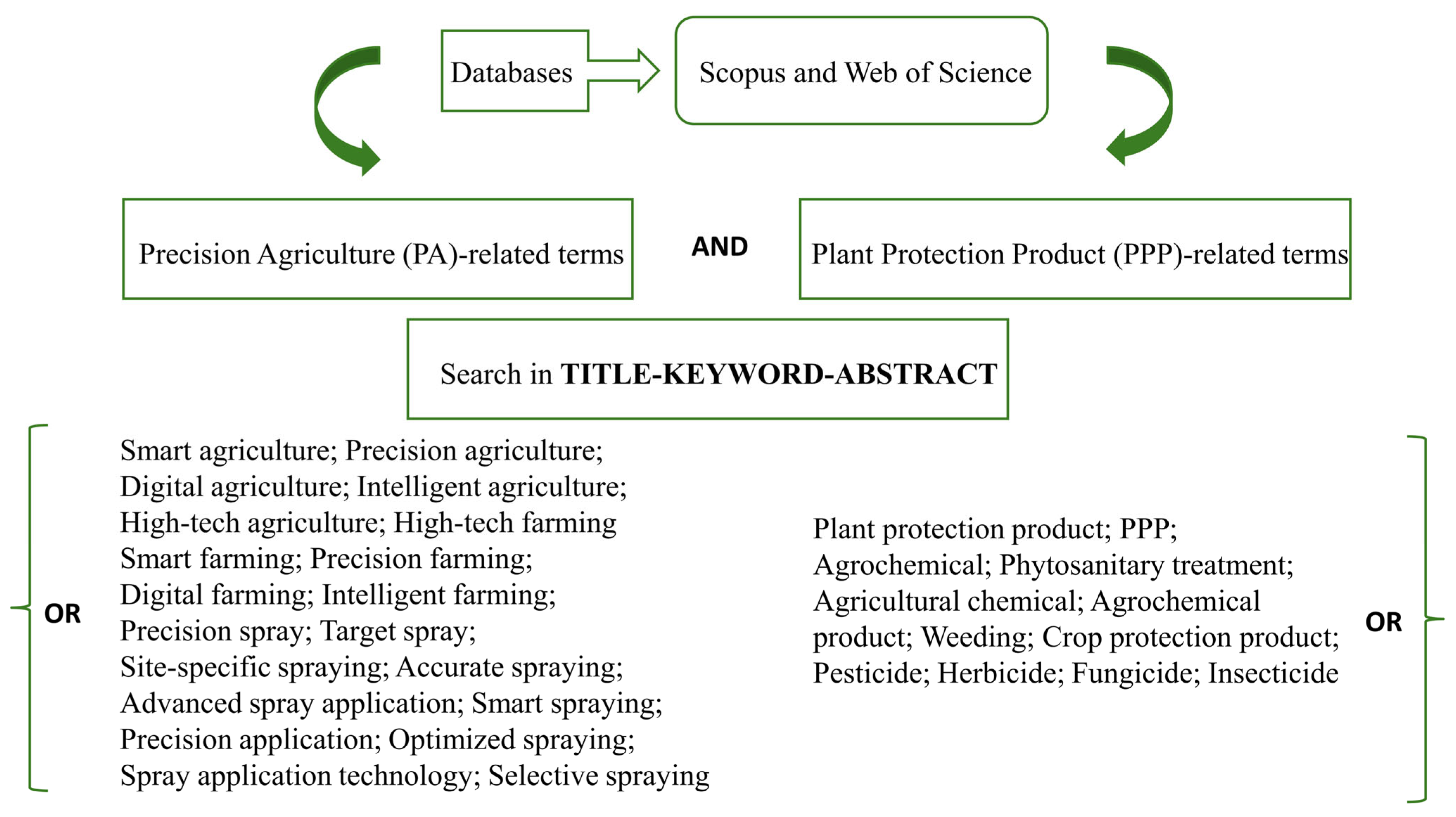

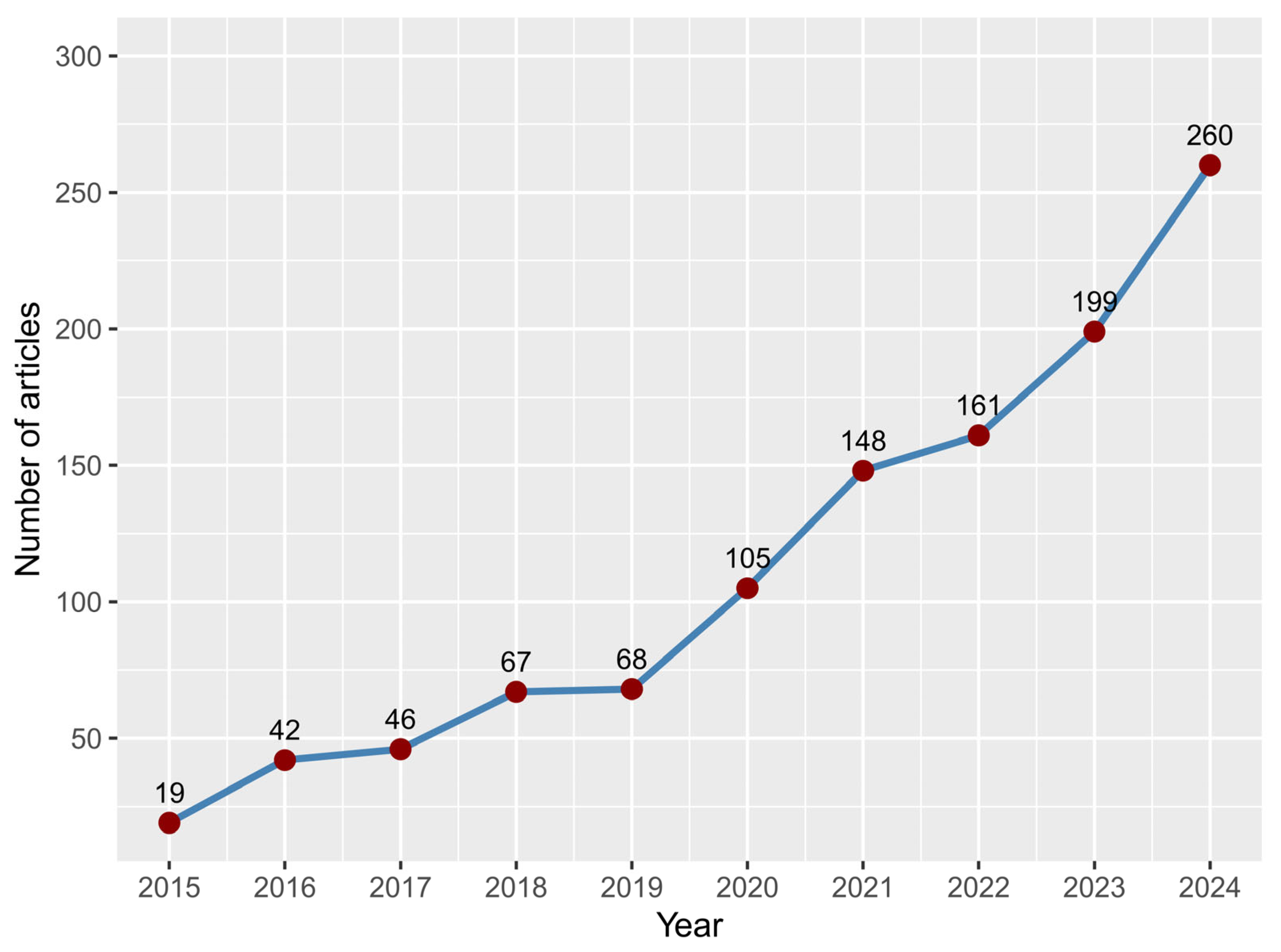

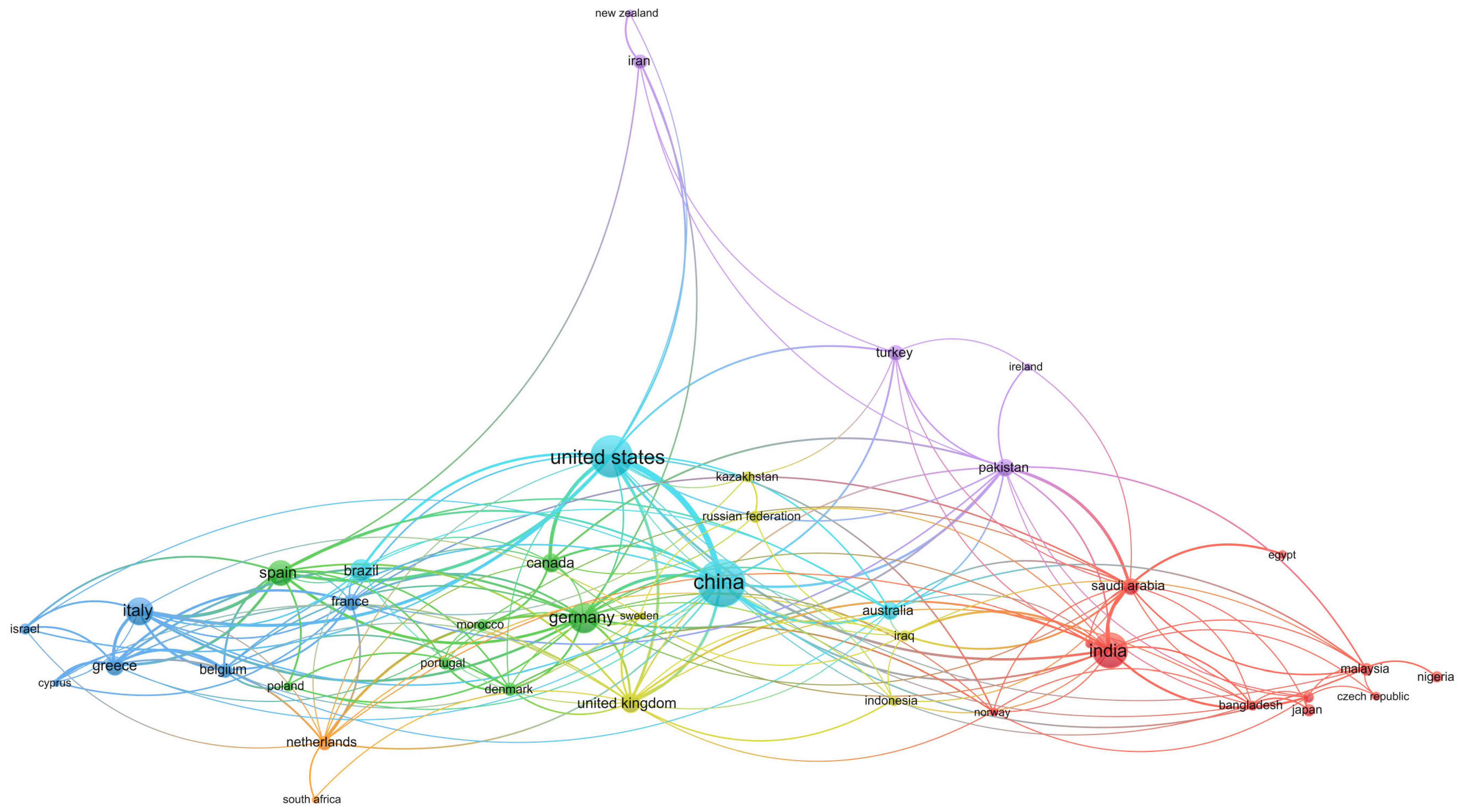
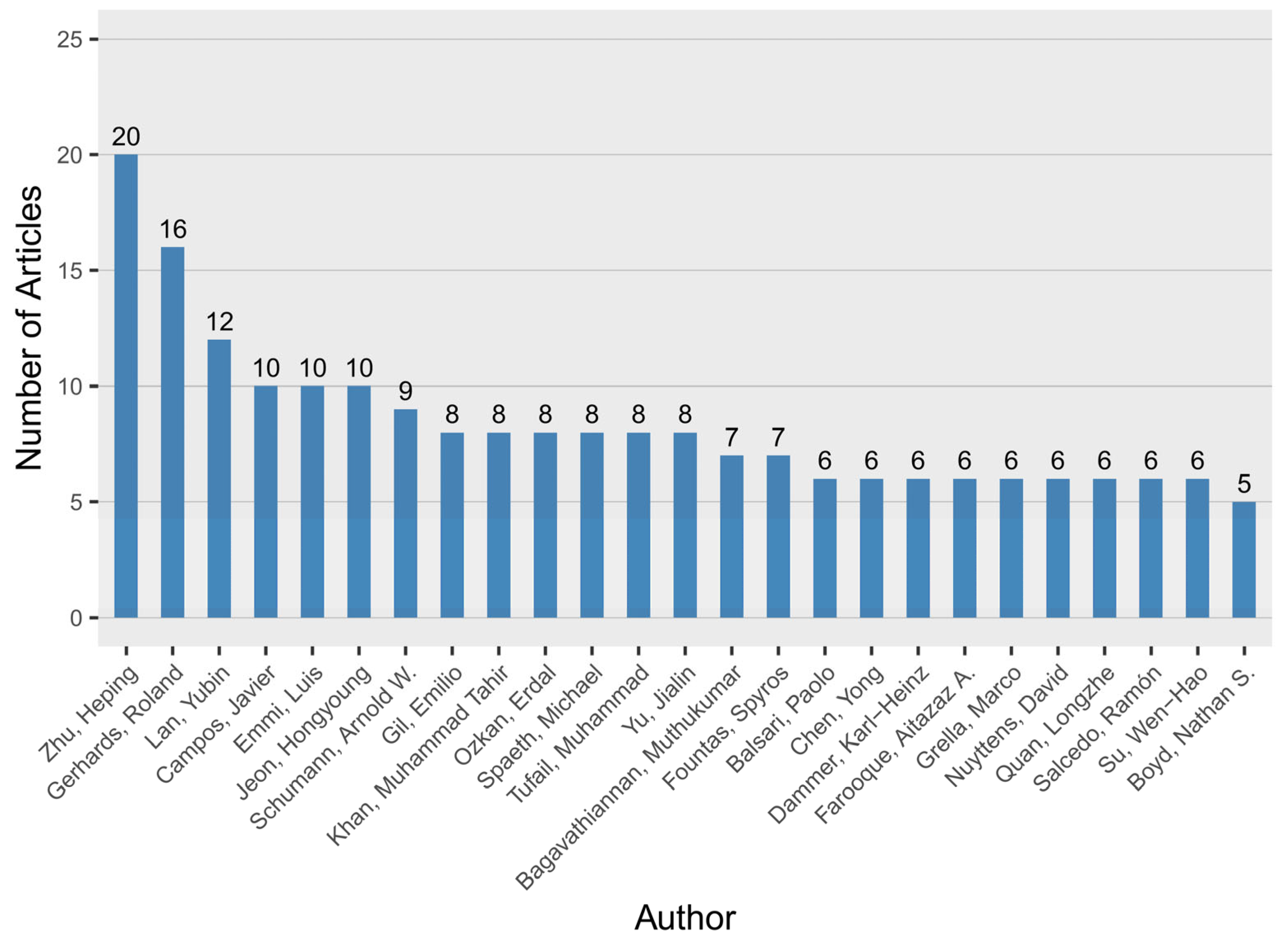
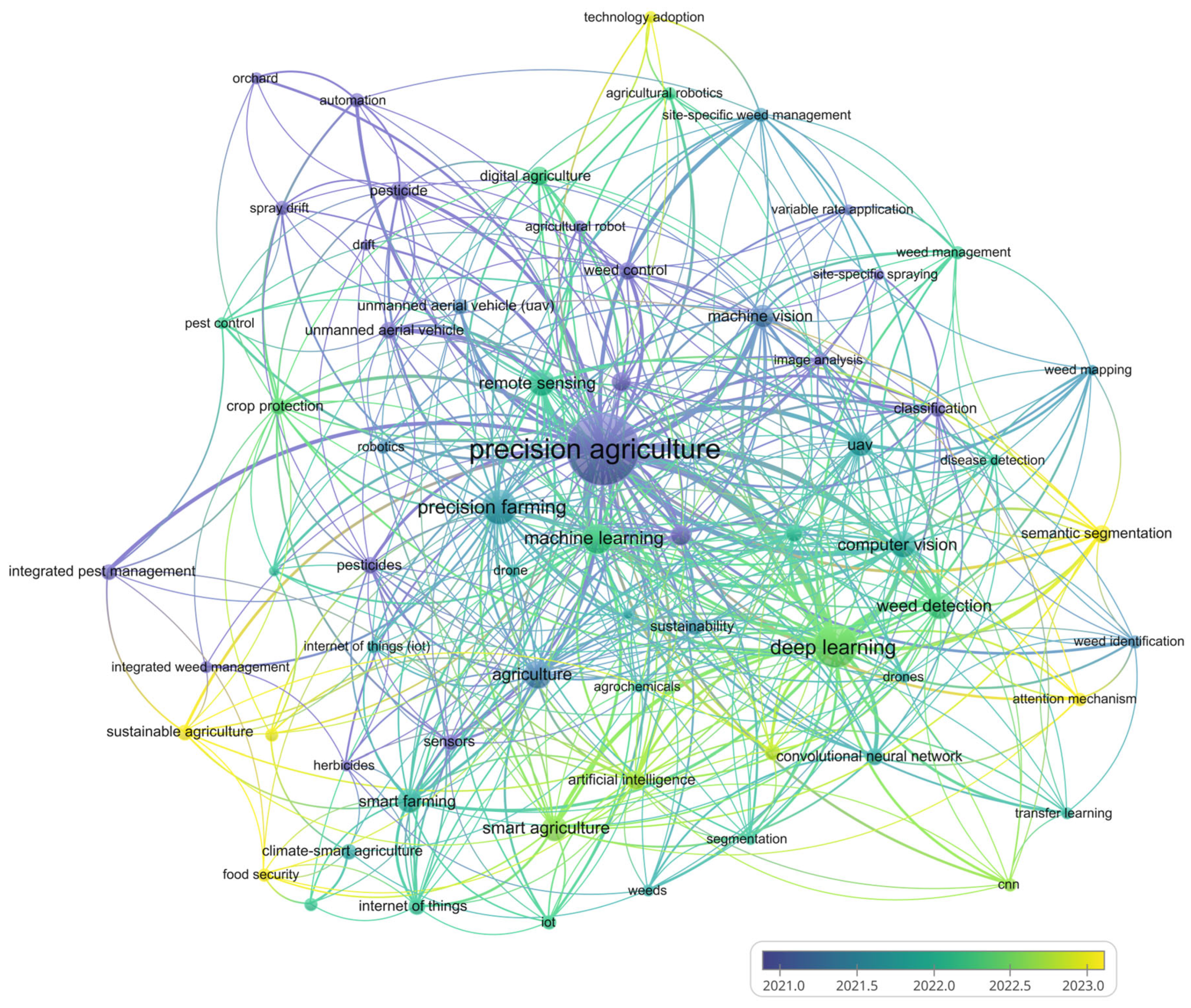
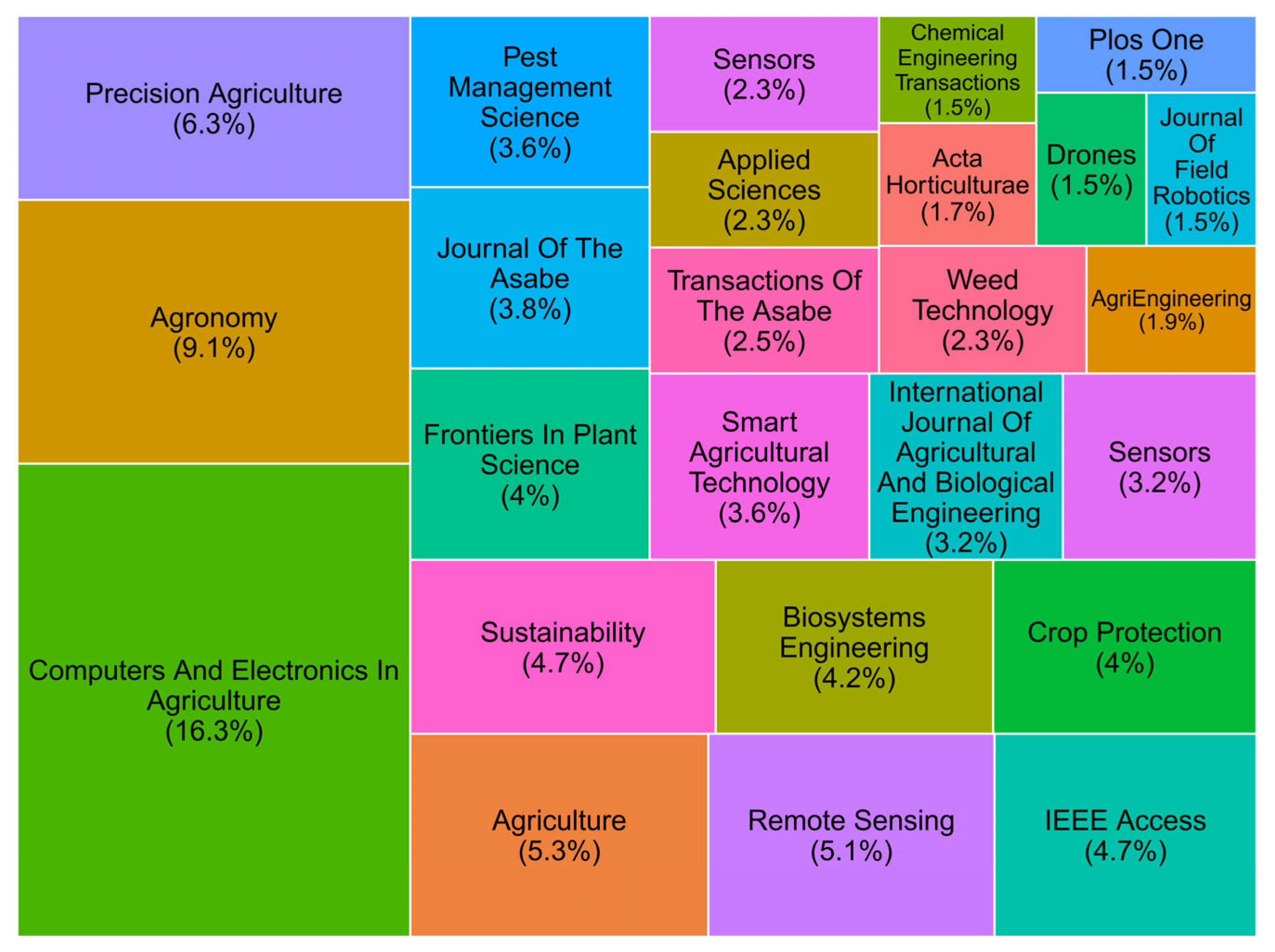
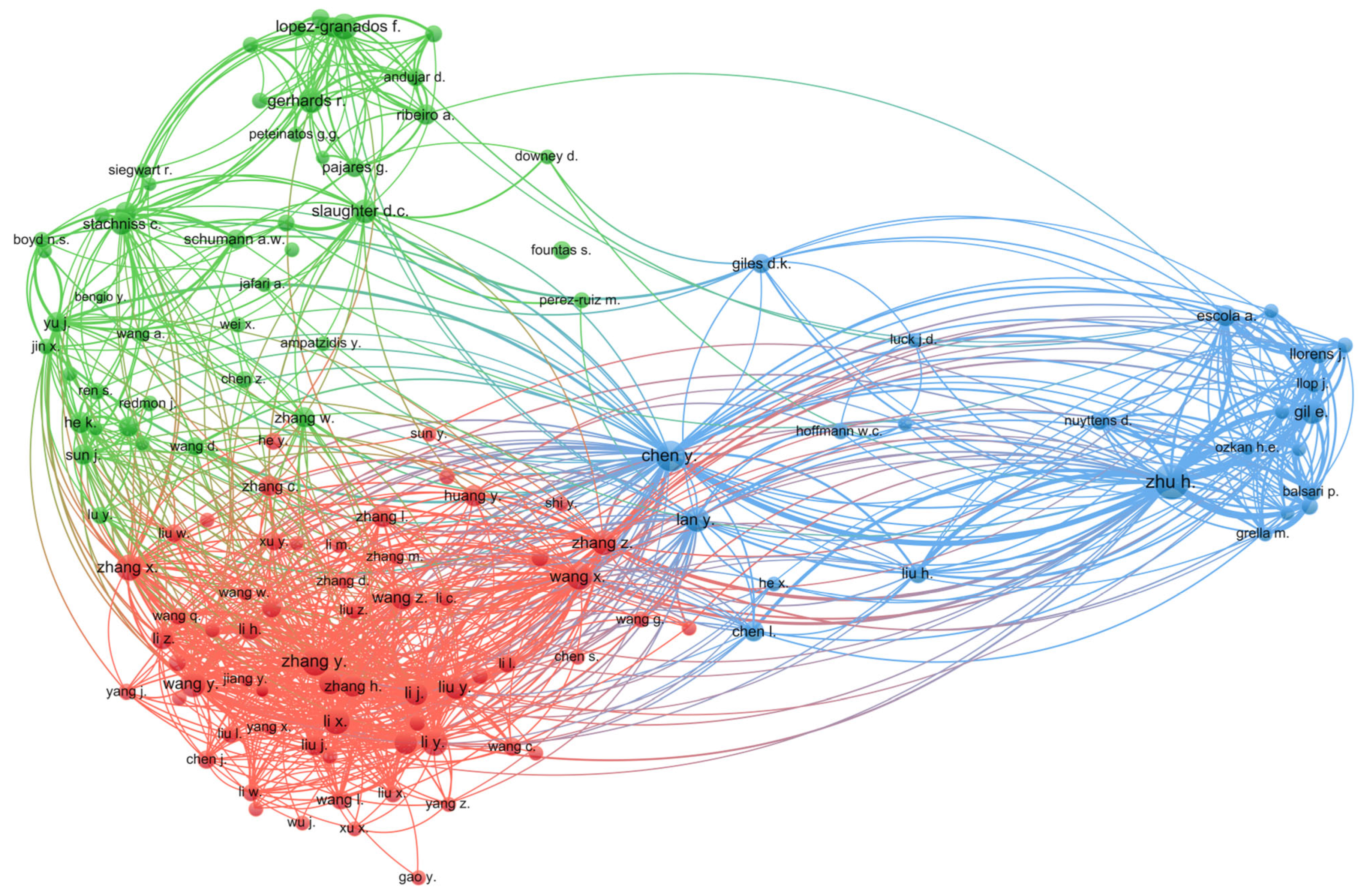
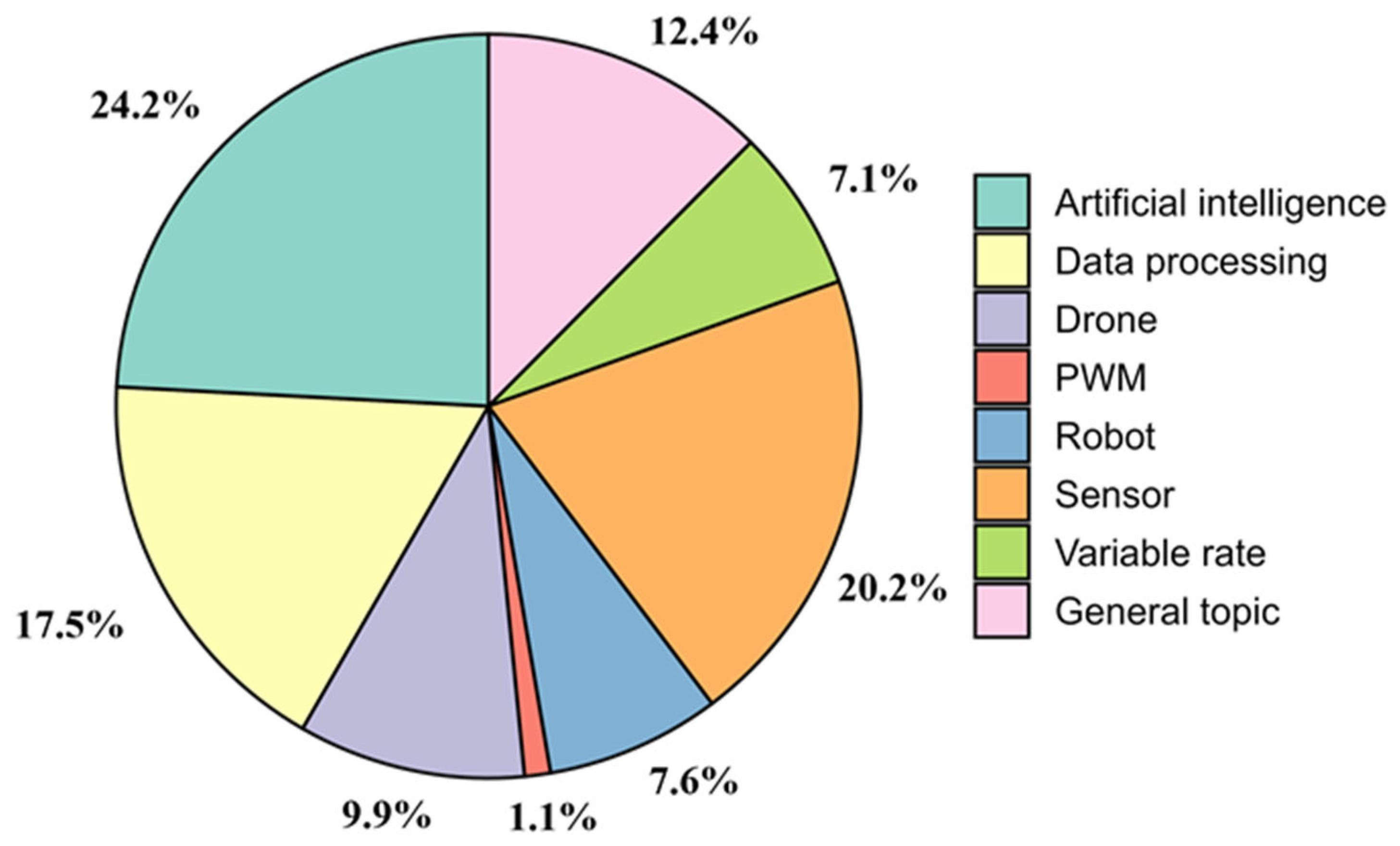

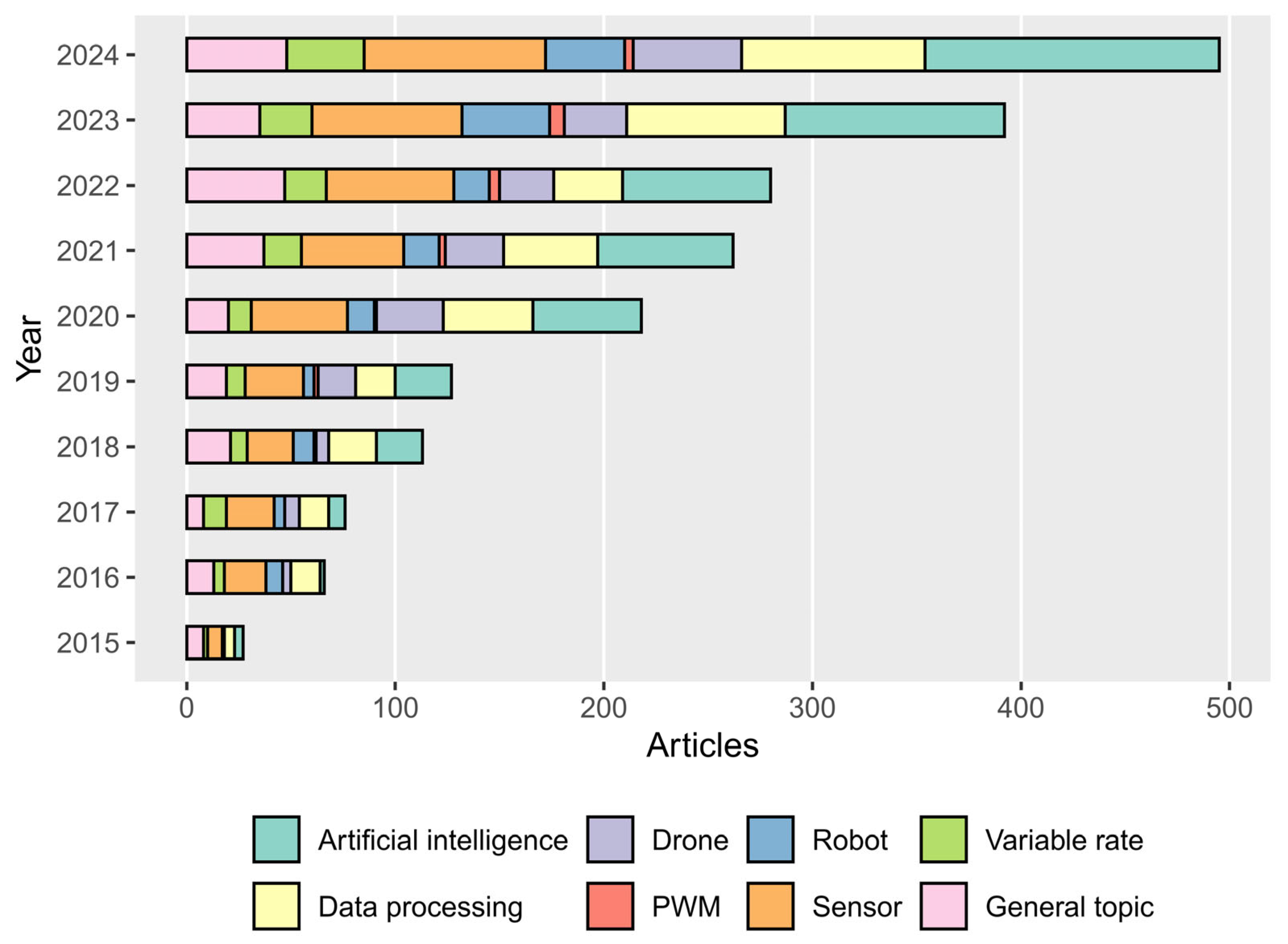

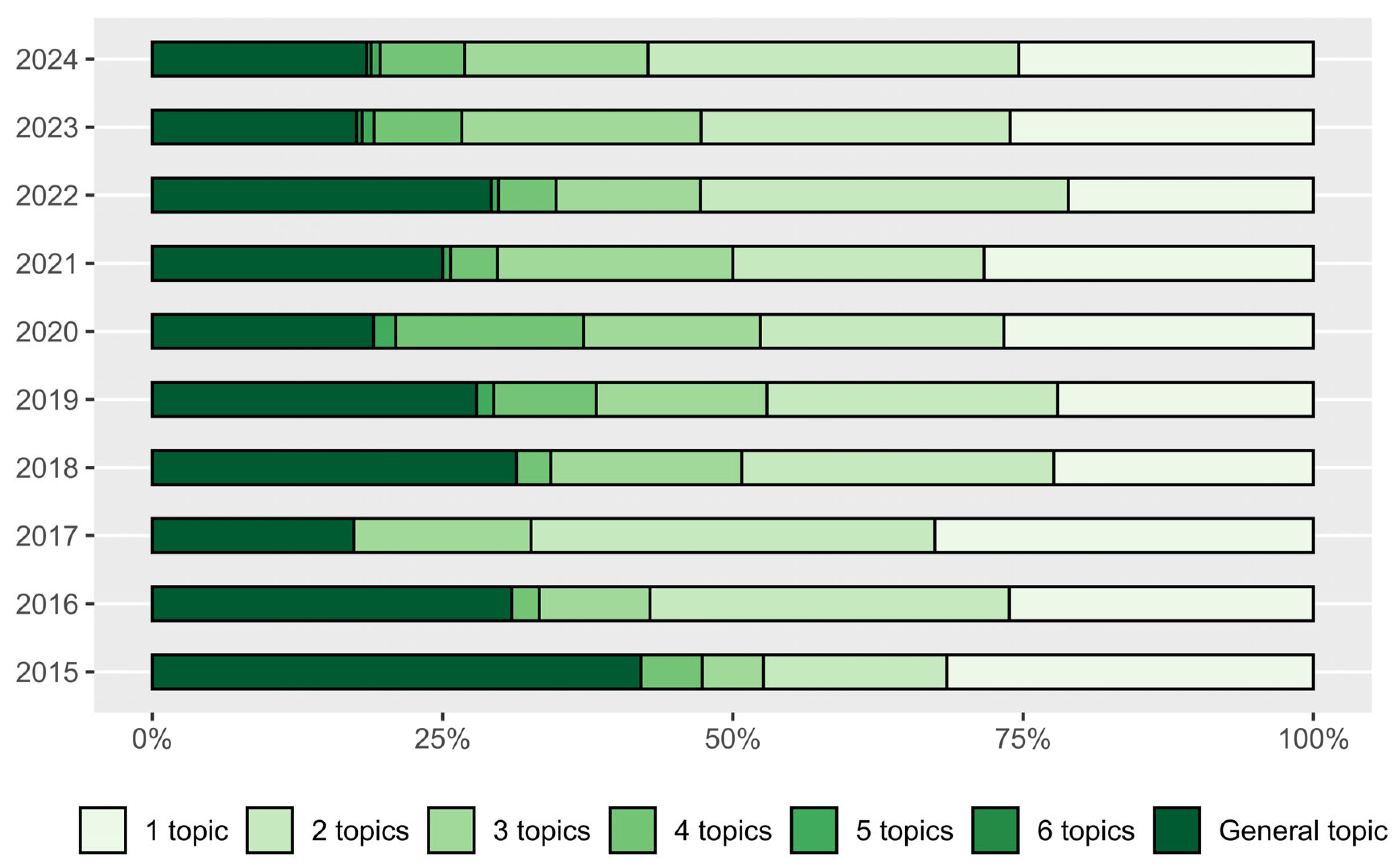
| Sub-Category (Topic) | Specific Keywords |
|---|---|
| Variable-Rate Technology (VRT) | Variable rate; VRT; patch spray; variable spray; variable application; variable-rate spraying; VRS; controlled-rate spray; adaptive spray; variable-rate strategy; variable-rate technology; spraying system; sprayer automation; variable pesticide application; microdose spray; spot spray |
| Drone | UAV; drone; agricultural drone; aerial pesticide application; agricultural UAV sprayer; unmanned aerial vehicles; UASS; RPAS; aerial robot; copter; aerial application |
| Robot | UGV; robot spray; autonomous vehicle; agricultural robotics; unmanned ground vehicle; agri-robot; field robot; weeding robot; smart robotic; autonomous system; agrobot; robot; ugrobot; robot system; mobile robot; electrical robot |
| Pulse-Width Modulation (PWM) | PWM; solenoid valve; control valve; pulse-width modulation; electronic valve; intermittent valve |
| Data Processing (DP) | GIS; geographic information system; DSS; decision support system; spatial decision support system; prescription map; vigor map; weed mapping; map; GNSS; GPS; quantum geographic information system; QGIS; Machine vision; computer vision; decision-making; segmentation; image processing |
| Sensor | Remote sensing; remote sensor; satellite; proximal sensor; proximal sensing; sensor; lidar; radar; ultrasonic; multispectral camera; thermal camera; hyperspectral camera; flow sensor; pressure sensor; hygrometer; anemometer; temperature sensor; biosensor; RGB; sensitive detection; stereo vision; camera; pulsed thermography; hyperspectral imaging; digital twin |
| Artificial Intelligence (AI) | AI; IoT; internet of things; artificial intelligence; machine learning; ML; deep learning; DL; neural network; CNN; YOLO; algorithm |
| Number of Topics Per Document | Number of Documents | Percentage of Total |
|---|---|---|
| General topic | 256 | 23.0 |
| One topic | 284 | 25.5 |
| Two topics | 308 | 27.6 |
| Three topics | 181 | 16.2 |
| Four topics | 75 | 6.7 |
| Five topics | 9 | 0.8 |
| Six topics | 2 | 0.2 |
| Total | 1115 | 100 |
| Topic | Number of Documents | Percentage of Papers of a Topic Dealing with Other Topics | ||||||
|---|---|---|---|---|---|---|---|---|
| VRT | Drone | Robot | PWM | DP | Sensor | AI | ||
| Variable-Rate Technology (VRT) | 141 | 100 | 11 | 9 | 7 | 23 | 26 | 24 |
| Drone | 199 | 8 | 100 | 7 | 0 | 22 | 31 | 32 |
| Robot | 149 | 8 | 8 | 100 | 1 | 27 | 22 | 34 |
| Pulse-Width Modulation (PWM) | 23 | 44 | 0 | 5 | 100 | 15 | 28 | 8 |
| Data Processing (DP) | 345 | 9 | 12 | 12 | 1 | 100 | 26 | 39 |
| Sensor | 398 | 11 | 17 | 10 | 2 | 26 | 100 | 34 |
| Artificial Intelligence (AI) | 497 | 8 | 15 | 14 | 0 | 33 | 29 | 100 |
| VRT | Drone | Robot | PWM | DP | Sensor | AI | |
|---|---|---|---|---|---|---|---|
| Variable-Rate Technology | *** | ** | ** | * | *** | *** | *** |
| Drone | ** | *** | * | NA | *** | *** | *** |
| Robot | * | ** | *** | ns | *** | *** | *** |
| Pulse-Width Modulation | *** | NA | ns | *** | *** | *** | ns |
| Data Processing | *** | ** | *** | * | *** | *** | *** |
| Sensor | ** | ** | *** | ** | *** | *** | *** |
| Artificial Intelligence | *** | *** | *** | ns | *** | *** | *** |
Disclaimer/Publisher’s Note: The statements, opinions and data contained in all publications are solely those of the individual author(s) and contributor(s) and not of MDPI and/or the editor(s). MDPI and/or the editor(s) disclaim responsibility for any injury to people or property resulting from any ideas, methods, instructions or products referred to in the content. |
© 2025 by the authors. Licensee MDPI, Basel, Switzerland. This article is an open access article distributed under the terms and conditions of the Creative Commons Attribution (CC BY) license (https://creativecommons.org/licenses/by/4.0/).
Share and Cite
Lupica, S.; Privitera, S.; Trusso Sfrazzetto, A.; Cerruto, E.; Manetto, G. Toward Modern Pesticide Use Reduction Strategies in Advancing Precision Agriculture: A Bibliometric Review. AgriEngineering 2025, 7, 346. https://doi.org/10.3390/agriengineering7100346
Lupica S, Privitera S, Trusso Sfrazzetto A, Cerruto E, Manetto G. Toward Modern Pesticide Use Reduction Strategies in Advancing Precision Agriculture: A Bibliometric Review. AgriEngineering. 2025; 7(10):346. https://doi.org/10.3390/agriengineering7100346
Chicago/Turabian StyleLupica, Sebastian, Salvatore Privitera, Antonio Trusso Sfrazzetto, Emanuele Cerruto, and Giuseppe Manetto. 2025. "Toward Modern Pesticide Use Reduction Strategies in Advancing Precision Agriculture: A Bibliometric Review" AgriEngineering 7, no. 10: 346. https://doi.org/10.3390/agriengineering7100346
APA StyleLupica, S., Privitera, S., Trusso Sfrazzetto, A., Cerruto, E., & Manetto, G. (2025). Toward Modern Pesticide Use Reduction Strategies in Advancing Precision Agriculture: A Bibliometric Review. AgriEngineering, 7(10), 346. https://doi.org/10.3390/agriengineering7100346











